Writing in English High Beginning+
Step-by-step Lesson Plans
Table of Contents
- Introduction
- Lesson One: Pre-Assessment
- Lesson Two: Chapter 1
- Lesson Three: Chapter 2
- Lesson Four: Chapter 3
- Lesson Five
- Lesson Six
- Lesson Seven
- Lesson Eight
- Lesson Nine: Chapter 4
- Lesson Ten
- Lesson Eleven
- Lesson Twelve
- Appendix
Introduction:
FOCUS

>Writing in English - High Beginning+ and Writing in English - Intermediate+ build awareness of common errors with over 400 (combined count for both levels) screens of interactive presentations and practices. Clear explanations of grammar rules engage learners with interactive activities. Like a series of puzzle boxes, which open up to reveal smaller boxes nesting inside the larger ones, these programs begin with an interactive presentation on the grammar rules. Next, the learner is prompted to click on specific words, which then change color and open dialogue boxes to reveal more information or examples of usage.
Traditionally, learners are passive at the presentation stage of the lesson, listening to a lecture or reading text. Often, too much information is presented at this stage, and there's too much for the learner to absorb. The interactivity at this first stage of the lesson ensures:
- Learners are engaged and paying attention.
- Learners are presented with information that slowly unfolds to reveal more details.
Navigation

At the main Table of Contents, there are now two kinds of ‘roll over' flash menus:
- Mouse over the magnifying glass at the bottom of the tool bar and a program level index appears.
- Mouse over each chapter and a chapter level index appears.

TOEFL® Skill Builder Buttons
Mouse over the TOEFL® skill builder buttons in each section to get specifics on how this program will help build skills required for the TOEFL® test.

Target Audience
Writing in English - High Beginning+ identifies common errors for nonnative writers at the high beginning through intermediate level. (Of course, many students, even at the advanced level, may find this program helpful to work on using verbs and gerunds correctly.)
Writing in English - Intermediate+ identifies common errors for nonnative writers at the intermediate through advanced level.
Multiple Learning Styles
The colorful graphics, highlighting, interactivity, and automatic scoring appeal to multiple learning styles.
Format
The material is available online. It works on all devices and operating systems including: desktop, laptop, tablets, phones running Window, Mac, Android, iOS
Customers
This program is used at schools like Iowa State University and the University of South Carolina.
Organization
Pre-assessment/ post assessment
Both levels of the program begin with a pre-assessment, which has five rotating versions. Students complete 50 items and receive a score. This score can be compared to their post-assessment score at the end to measure improvement.
Interactive presentations
Grammar rules are introduced through interactive presentations that involve the learner. This process prevents learners from being overwhelmed with too much information at one time.
Interactive practices
Interactive practices follow each presentation and provide immediate feedback on answers with automatic scoring.
Application activities
The content in the application section is generated by students. These activities guide students in applying the rules presented in the program to their writing. This will help bridge the gap between the classroom and the world outside, which is always a challenge.
Paragraph level reviews
Paragraph level reviews provide opportunities to identify errors and edit. Of course, for many practices and reviews, there is more than one correct answer. The "back end" programming supports multiple correct answers. This is one of the many invisible advantages to an interactive program.
The Common Errors List

A unique tool inside the program, The Common Errors List, allows students to capture their own mistakes with corrections as they move through the program.
Chapter One: Verbs and Chapter Two: Parts of a Sentence
The first two chapters build sequentially. Chapters One and Two quickly review parts of speech as sometimes students get confused about these. For example, some students identify the adjective "accomplished" as a verb in sentence five from practice 1.3, "He was already an accomplished scientist when he moved to the new job."
Chapter Three: Using Verbs in Sentences
Chapter Three is important for establishing clarity with verb tenses. Again, even advanced level writers are often confused about verb tense. This chapter has multiple practices with mistakes taken from students' written communication. Using verbs accurately is critical to effective academic writing and effective email writing at work.
Chapter Four: Problems with Gerunds and Infinitives
Chapter Four extends the work with verbs to focus on gerunds and infinitives.
Appendix
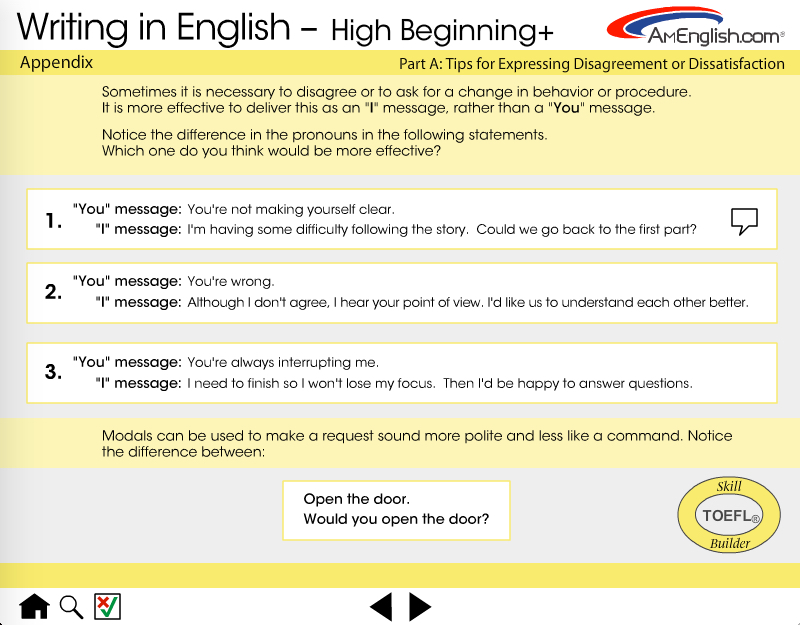
The Appendix covers the following: "You vs. I" messages, punctuation, guidelines and examples for effective voicemail/email, common verbs at work, and irregular verbs.
Lesson One: Pre-Assessment
Warm-up
Elicit from the class what is most difficult for them about writing in English. This can be a done as a whole class exercise with the teacher writing students' comments on the board.

Pre-Assessment
Have students take the pre-assessment, so that there is a score to compare to the post- assessment at the end of the program. Lower the affective filter by telling students that if they get a perfect score, they don't need to be in the class.
Notes for Teachers:
- This will give students a baseline and an awareness of their shortcomings.
- It will also intensify students' focus on the material in the programs.
- Teachers can compare scores on the pre-assessment with the post-assessment to measure improvement.
User Interface Tour
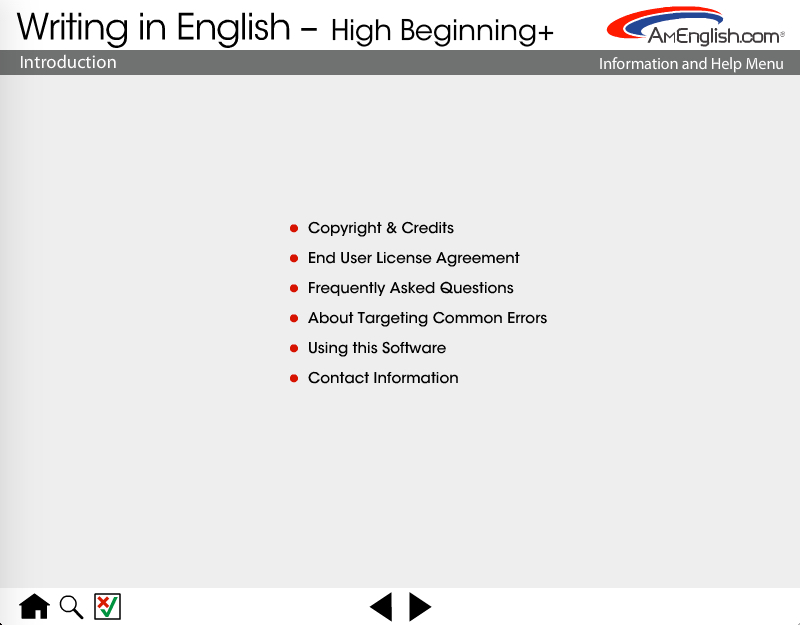
Spend some time in the lab with the program on the screen to give students a quick tour of the navigation. Make sure students know how to use the "Choose your language" button at the Table of Contents screen.
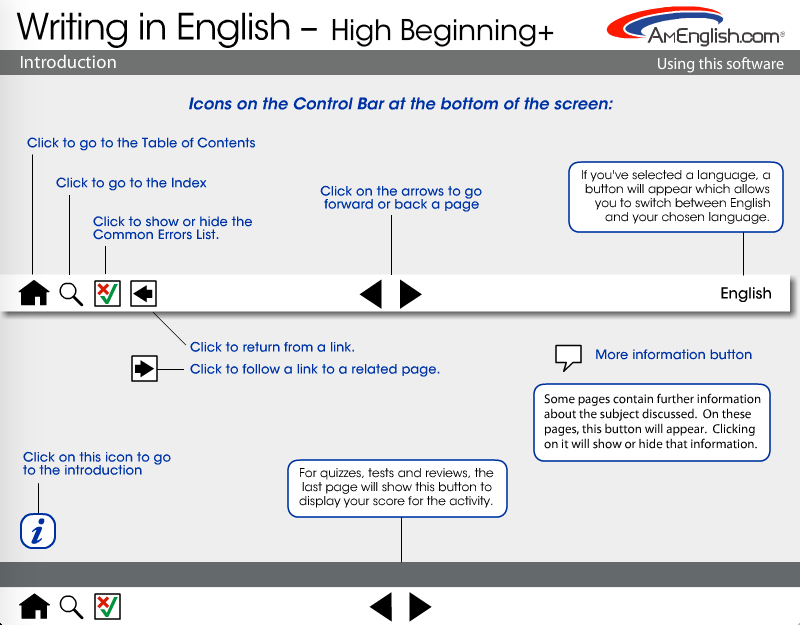
Show students the "About Targeting Common Errors" and "Using this software" sections in the Introduction. Make sure they know how to set the language button at the Table of Contents and how to toggle back and forth between English and the language they selected on each screen.
Overview
- Show the table of contents with 4 chapters & the pre and post- assessments.
- Click on the magnifying glass at the bottom left of the screen to show them the detailed index.
- Mouse over the chapter buttons on the Table of Contents to show the short Flash list of steps for each chapter.
- Take them to chapter one and show them the instructions in each step presentation. For example in step 1, clicking on the verbs in the examples, will reveal more information. Clicking on the empty dialogue box at the right will reveal further information.
- Mouse over the TOEFL® Skill Builder button to get specifics on how this program will help build skills required for the TOEFL® test.
- Take students to practice 1.1 in chapter one to show them the scoring.
- Remind students that the "Common errors list" works in Chapters Three and Four. Go to practice 3.1 to show them how it works by clicking on one of the item numbers. Note the graphic for the common errors list in the lower left of the screen.
On your own in the lab/Homework
Review Chapter One, completing all the practices
Lesson Two: Chapter 1
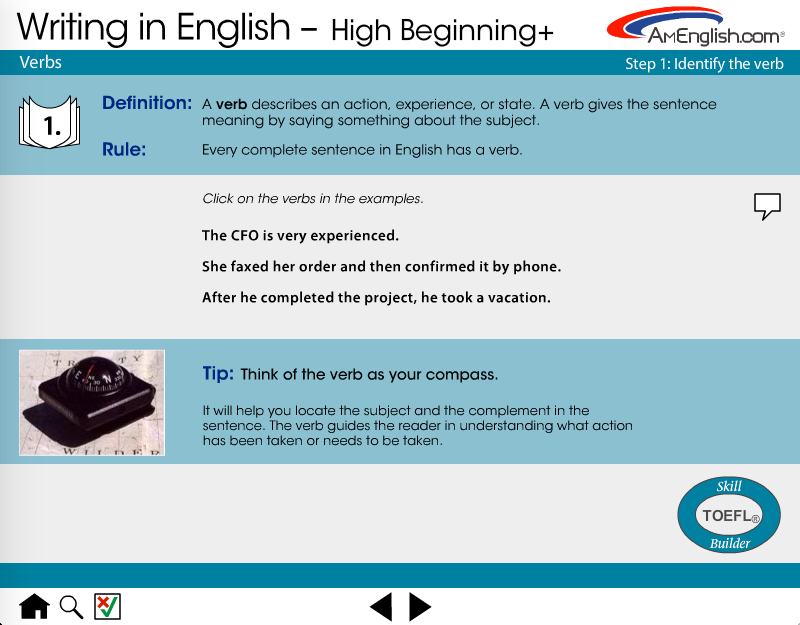
Identify verbs, modals, & active & passive voice
(Ideally, this is a review, but it can be a preview.)
Review: Whole class
This can be a whole class exercise with teachers facilitating the discussion.
Project "Step 1: Identify the verb" on the board. Elicit the verbs in each example from the class. Then, click on the verb to show the pop-up box with more information.
Practice
Divide the class into two teams. Project Practices 1.1 - 1.5, one at a time. Each team will have one chance to choose the correct answer. If they miss it, the question goes to the other team. Keep score.Whole class
What is the word "can" in the following sentence?,/p>
(answer: a modal; elicit more examples of modals from the class)
See Chapter 1; Step 2
Next, Project "Step 2: Identify modal auxiliaries" on the board. Elicit the modals in the second set of examples from the class. Then, click on the modals to show the pop-up box with more information.
Practice
Divide the class into two teams.
Project Practices 1.6 - 1.12 one at a time. Each team will have one chance to choose the correct answer. If they miss it, the question goes to the other team. Keep score.
Whole class
Project "Step 3: Identify active and passive voice" on the board. Elicit the verbs in the examples from the class. Then, click on the verbs to show the pop-ups.
See Chapter 1; Step 3
Practice
Divide the class into two teams.
Project Practices 1.13 & 1.14 one at a time
Each team will have one chance to choose the correct answer. If they miss it, the question goes to the other team. Keep score.
Reflect
Take a moment to reflect on the lesson and share with a partner/the group what you've learned. How will you apply it to your communication in English?
On your own in the lab/Homework
Review Chapter Two, completing all the practices
Lesson Three: Chapter 2
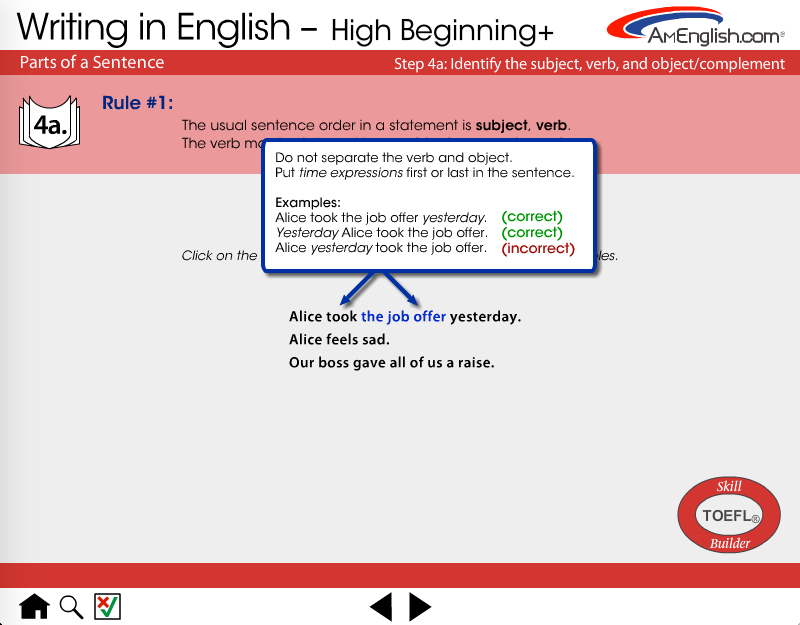
Identify the subject, verb, & object/complement
(Ideally, this is a review, but it can be a preview.)
Review: Whole class
This can be a whole class exercise with teachers facilitating the discussion.
Project "Step 4a: Identify the subject, verb, and object/complement" on the board. Elicit the subject, verb and object/complement in the examples from the class. Then, click on those words to show the pop-ups with more information.
See Ch. 2 Step 4a
Whole class
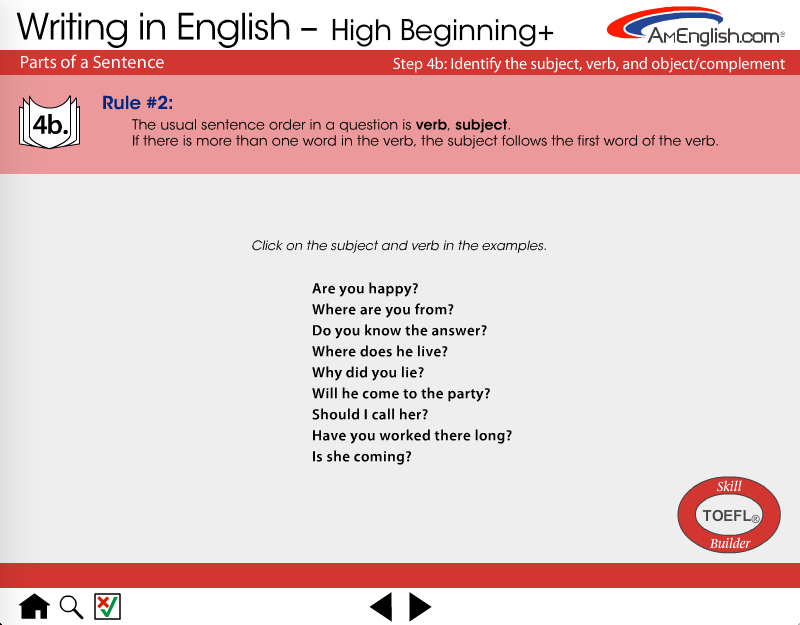
This can be a whole class exercise with teachers facilitating the discussion. Project "Step 4b: Rule #2" on the board. Elicit the subject and the verb in the examples from the class. Then, click on those words to show the pop-ups with more information.
See Ch. 2 Step 4b
Next, Project "Step 4c" on the board. Elicit volunteers from the class to read the questions.
Practice
Divide the class into two teams.
Project Practices 2.1 - 2.8 one at a time
Each team will have one chance to choose the correct answer. If they miss it, the question goes to the other team. Keep score.
Whole class
This can be a whole class exercise with teachers facilitating the discussion.
Ask students:
Note: The subject (you) is understood.
The teacher can read the sentences aloud and elicit answers or write the sentences on the board without marking the words and elicit answers.
See Ch. 2 Step 5
Practice
Divide the class into two teams.
Project Practices 2.9 & 2.10 one at a time
Each team will have one chance to choose the correct answer. If they miss it, the question goes to the other team. Keep score.
Reflect
Take a moment to reflect on the lesson and share with a partner/the group what you've learned. How will you apply it to your communication in English?
On your own in the lab/Homework
Review Steps 6a - 6c in Chapter Three; completing Practices 3.1 - 3.5 Review "Effective Voicemail & Email Messages" in the Appendix
Lesson Four: Chapter 3

Chapter 3 - Make the subject and verb agree
(Ideally, this is a review, but it can be a preview.)
Review: Whole class
Project "Step 6a & 6b: Make the subject and verb agree" on the board. Elicit the subject and the verb in the examples from the class. Then, click on those words to show the pop- ups with more information.
See Ch. 3 Step 6a & 6b
Group practice
Have students work in small groups or with partners to make three sentences choosing from the following subjects: news, economics, politics, series, physics, everyone, everybody, someone, somebody, & something.
Monitor for Grammar/syntax problems
The instructor can monitor results during this time to check for grammar/syntax mistakes in the sentences.
Groups/Partners share
Groups will take turns sharing their sentences orally with the class. The rest of the class will identify the subject and verb in each sentence.
Review
Whole class
This can be a whole class exercise with teachers facilitating the discussion.
Ask students:
The teacher can read the sentences aloud and elicit answers or write the sentences on the board without marking the words and elicit answers.
See Ch. 3 Step 6c; Rule #4
Group practice
Have students work in small groups or with partners to make three sentences using "there is" and "there are" and making sure the noun that follows agrees with the verb.
Monitor for Grammar/syntax problems
The instructor can monitor results during this time to check for grammar/syntax mistakes in the sentences.
Groups/Partners share
Groups will take turns sharing their sentences orally with the class. The rest of the class will identify the noun that follows the phrase "there is" or "there are" in each sentence.
Review: Whole class
This can be a whole class exercise with teachers facilitating the discussion. Project "Step 6c, Rule #5" on the board. Elicit the subject and the verb in the examples from the class. Then, click on those words to show the pop- ups with more information.
See Ch. 3 Step 6c; Rule #5
Group practice
This is an optional practice; the teacher can decide if it is appropriate for the class, depending on their level.
Have students work in small groups or with partners to make three sentences with a prepositional phrase after the subject like the example.
Monitor for Grammar/syntax problems
The instructor can monitor results during this time to check for grammar/syntax mistakes in the sentences.
Groups/Partners share
Groups will take turns sharing their sentences orally with the class. The rest of the class will identify the subject and verb in each sentence.
Review: Whole class
This can be a whole class exercise with teachers facilitating the discussion. Ask students:
The teacher can read the sentences aloud and elicit answers or write the sentences on the board without marking the words and elicit answers.
See Ch. 3 Step 6c; Rule #6
Group practice
Have students work in small groups or with partners to make three sentences using two subjects each and making sure the verb reflects that.
Monitor for Grammar/syntax problems
The instructor can monitor results during this time to check for grammar/syntax mistakes in the sentences.
Groups/Partners share
Groups will take turns sharing their sentences orally with the class. The rest of the class will identify the two subjects and the verb in each sentence.
Reflect
Take a moment to reflect on the lesson and share with a partner/the group what you've learned. How will you apply it to your communication in English?
On your own in the lab/Homework
Review Steps 7a & 7b in Chapter Three, completing Practices 3.6 - 3.33
Lesson Five
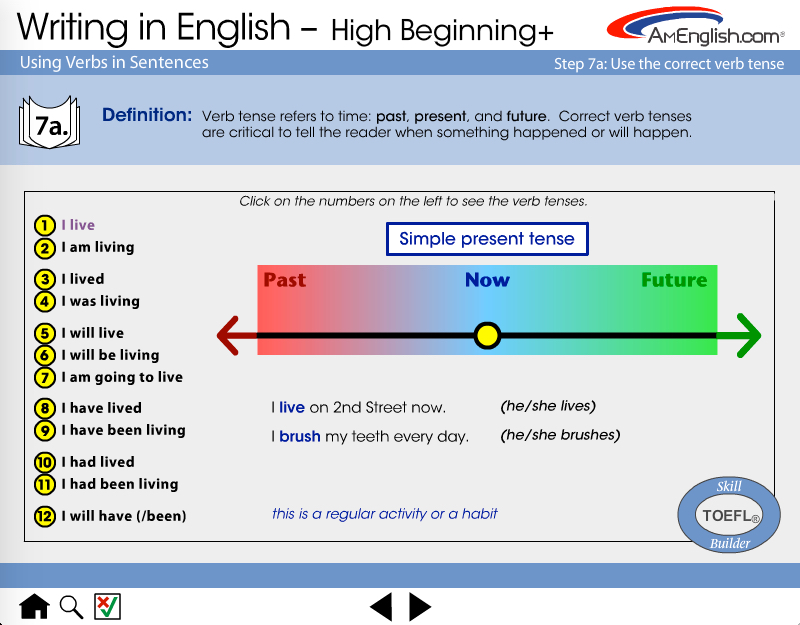
Chapter 3 - Using Verbs in Sentences
(Note: This lesson may take more time than others, as verb tenses are complicated.)
(Ideally, this is a review, but it can be a preview.)
Review
Whole class
This can be a whole class exercise with the teacher facilitating the discussion.
Ask students:
Teachers will elicit these examples from students and correct any problems.
This is a good time to discuss the fact that native speakers do not use #10 (past perfect) that often. It is mainly used when there are two events in the past, and the speaker wants to make sure it is clear which one came first.
See Ch. 3 Step 7a & 7b
- I live
- I am living
- I lived
- I was living
- I will live
- I will be living
- I have lived
- I have been living
- I had lived
- I had been living
- I will have (/been)
The interactive chart in Step 7a is very useful, and the teacher may decide to project it on the board in the classroom for this lesson.
Group practice
Divide the class into 4 sections. Each section will work with 3 verb tenses. Have students work in small groups or with partners to make two sentences each for the 3 tenses.
Monitor for Grammar/syntax problems
The instructor can monitor results during this time to check for grammar/syntax mistakes in the sentences.
Groups/Partners share
Groups will take turns sharing their sentences orally with the class. The rest of the class will give a "thumbs up" or "thumbs down" depending on whether they think the sentence is using the verb tense correctly. If students do not give enough information for students to tell if the verb tense is correct, students can use a "thumbs to the side."
For example:
Whole Class
The student work will give the instructor more information on what verb tenses are still confusing for students. Then he/she can review these. It's worth the time clarifying verb tenses here before moving on as even advanced level students often make mistakes when using the simple present and the present progressive tense in conversation.
Review: Whole class
This can be a whole class exercise with the teacher facilitating the discussion.
Ask students:
Give me the simple past and the past participle of the following irregular verbs:
The interactive chart in Step 7b is very useful and the teacher may decide to project it on the board in the classroom for this lesson.
Group practice
Divide the class into 8 sections. Have each section group choose 6 verbs from that section on the chart and supply the simple past & past participle. (Note: these sections correspond to the groups you see when you click on the chart – in Step 7b)
Monitor for Grammar/syntax problems
The instructor can monitor results during this time to check for grammar/syntax mistakes in the sentences.
Groups/Partners share
Groups will take turns sharing their verbs orally with the class. The rest of the class will give a "thumbs up" or "thumbs down" depending on whether they think the simple past & past participles are correct.
Reflect
Take a moment to reflect on the lesson and share with a partner/the group what you've learned. How will you apply it to your communication in English?
On your own in the lab/Homework
Review Step 8 in Chapter Three, completing Practices 3.34 - 3.40
Lesson Six
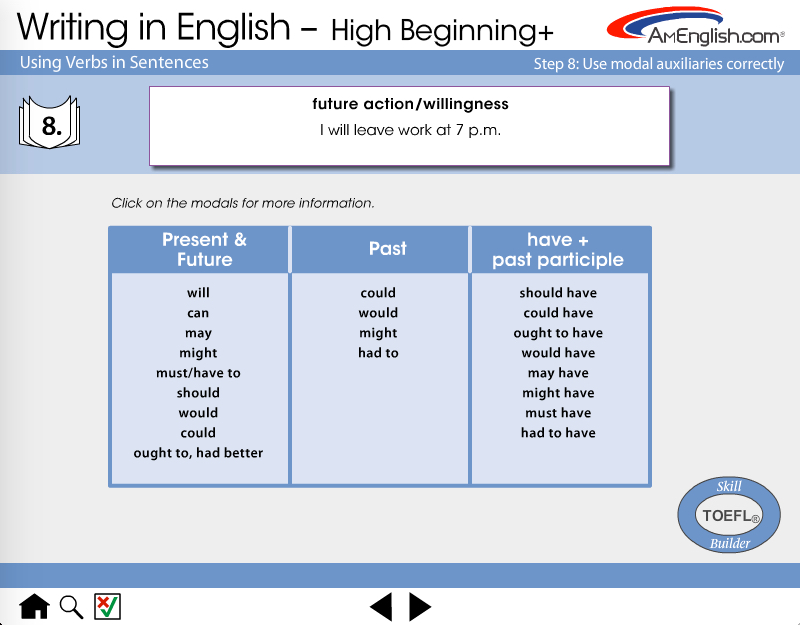
Step 8 - Use modal auxiliaries correctly
(Ideally, this is a review, but it can be a preview.)
Review
Whole class
This can be a whole class exercise with the teacher facilitating the discussion.
Warm-up
Elicit some examples of modals from the class: will, can, may, could, and so on. Write these on the board. Divide them up into present & future vs. past references. See chart for step 8 for groups & example sentences. (Some of this labeling depends on context, of course.)
Project the chart for step 8 on the board
Elicit examples for each modal from the chart in the first two categories, Present & Future and Past. Correct any problems. Then click on the chart to show the examples that pop up in the boxes when you click on the modals in the chart.
Take a minute to review the definition at the top of the box that pops up for each modal. Click on "must/have to" and then "should."
Ask students:
Next, click on examples from the 3rd category on the chart:
After showing each example, elicit more examples of sentences from the class.
>Talk about the fact that native speakers use many of the modals in this last category when they make excuses for not doing something.
For example:
This is what makes mistakes with "would" problematic. For example: if a native speaker receives the following email, he/she may be confused.
See practice 3.40, #1
Group practice
Have students work in small groups or with partners to make sentences with modals.
Monitor for Grammar/syntax problems
The instructor can monitor results during this time to check for grammar/syntax mistakes in the sentences.
Groups/Partners share
Groups will take turns sharing their sentences orally with the class. The rest of the class will identify whether the sentence refers to the present & future or the past.
Reflect
Take a moment to reflect on the lesson and share with a partner/the group what you've learned. How will you apply it to your communication in English?
On your own in the lab/Homework
Review Steps 9a & 9b
Complete practices 3.41-3.52
Lesson Seven

Steps 9a & 9b - Use "do" correctly to form negative sentences & questions
(Ideally, this is a review, but it can be a preview.)
Review
Whole class
This can be a whole class exercise with the teacher facilitating the discussion.
- Elicit some examples of questions with "do."
- Put them on the board.
- Elicit some examples of negative statements with "do." 4. Put them on the board.
Group practice - Teams
Divide the class into two teams. Project practices 3.42 - 3.48 on the board one at a time. Each team has one minute to rearrange the words into questions or negative sentences (depending on the directions). Keep score.
Whole class
Write the following sentences on the board (see practice 3.49):
Ask for volunteers to change them to:
- Questions
- Negative statements
Group practice - Teams
Next project practices 3.50 - 3.52 on the board one at a time. Each team has one minute to change the sentence to a question. Keep score.
Reflect
Take a moment to reflect on the lesson and share with a partner/the group what you've learned. How will you apply it to your communication in English?
On your own in the lab/Homework
Review Step 10
Complete Practices 3.53 - 3.66
Lesson Eight
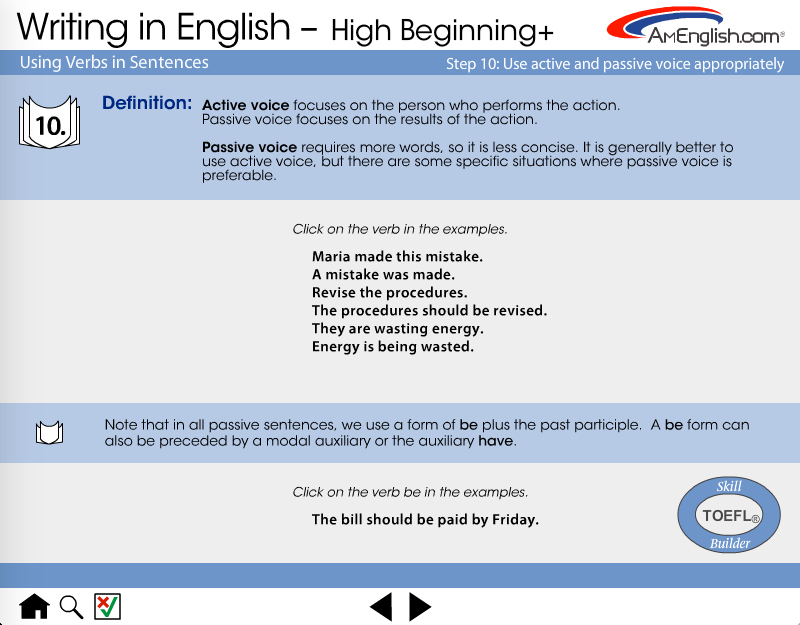
Step 10 - Use active and passive voice appropriately
(Ideally, this is a review, but it can be a preview.)
Review
Whole class
Write the following sentences on the board:
- Ask volunteers to change them to passive voice.
- Ask the class to tell you which is generally better to use, active or passive voice. (active)
- Ask them to give examples of specific situations where passive voice is preferable. (See pop-ups on Step 10 examples)
Group practice I - Teams
Divide the class into two teams. Project practices 3.57 - 3.60 on the board one at a time. Each team has one minute to change the passive sentences into actives sentences. Keep score.
Group practice II - Teams
Project practices 3.63 - 3.66 on the board one at a time. Each team has one minute to correct the mistakes in the passive sentences. Keep score.
Group practice III - Teams - Chapter Review
Project Reviews 1 & 2 on the board one at a time. Each team has one minute to correct the mistakes. Keep score.
Reflect
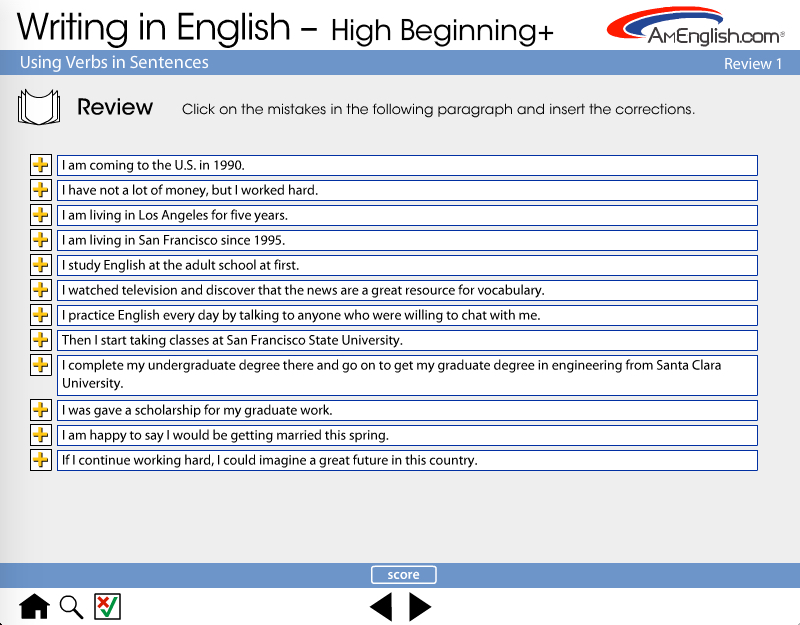
Take a moment to reflect on the lesson and share with a partner/the group what you've learned. How will you apply it to your communication in English?
On your own in the lab/Homework
Take the Chapter Review for Chapter 3 Review Steps 11a - 11e
Complete Practices 4.1 - 4.7
Lesson Nine: Chapter 4
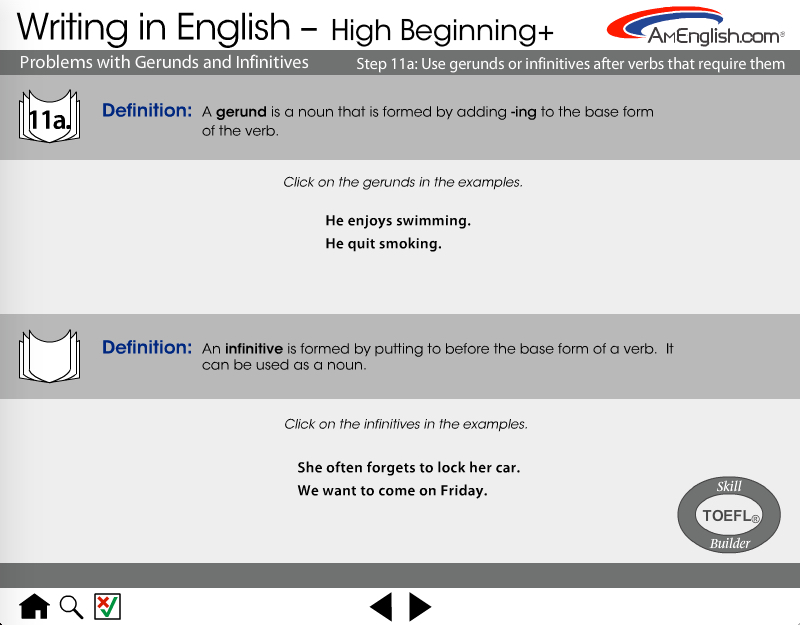
Steps 11a - 11e Use gerunds or infinitives after verbs that require them
(Ideally, this is a review, but it can be a preview.)
Review - Gerunds vs. Infinitives
Whole class
Write the following sentences on the board:
Elicit the gerunds.
Write the following sentences on the board:
Elicit the infinitives.
Project chart 11b on the board.
Click on the word "advise." Talk about the difference between the two example sentences:
- I advised leaving early.
- I advised him to leave early.
Elicit a few sentences using verbs from both charts from the class.
Practice
Turn off the projector so students can no longer see the charts. Distribute index cards with the verbs from both charts - one verb per card. Have students form two groups. Students who have verbs that require gerunds go to the left side of the classroom; students who have verbs that require infinitives go to the right side of the classroom.
Next have individuals make a sentence using the verb on their card. Share it with the class orally.
Review - Gerunds vs. Infinitives
Whole class
Write the following sentences on the board:
State the rule from step 11d (see pop ups)
Elicit sentences with "forget" & "remember" from the class using gerunds & infinitives.
Group practice
Have students work in small groups or with partners to make sentences with "forget" & "remember" like the examples on the board. Have students write about something they remember from their country, like a special food, person, or place.
Monitor for Grammar/syntax problems
The instructor can monitor results during this time to check for grammar/syntax mistakes in the sentences.
Groups/Partners share
Groups will take turns sharing their sentences orally with the class. The rest of the class will identify whether the sentence has a gerund or infinitive.
Reflect
Take a moment to reflect on the lesson and share with a partner/the group what you've learned. How will you apply it to your communication in English?
On your own in the lab/Homework
Review Steps 12 & 13
Complete Practices 4.8 - 4.18
Lesson Ten

Step 12 & Step 13
Use gerunds after prepositions & Use infinitives in other ways
Review - Use gerunds after prepositions
Whole class
Write the following sentences on the board: See Step 12
- Elicit the prepositions & the gerunds.
- Elicit more examples of prepositions from the class.
- Write them on the board.
Group practice
Have students work in small groups or with partners to make sentences with prepositions & gerunds like the examples on the board.
Monitor for Grammar/syntax problems
The instructor can monitor results during this time to check for grammar/syntax mistakes in the sentences.
Groups/Partners share
Groups will take turns sharing their sentences orally with the class. The rest of the class will identify the prepositions & the gerunds.
Review - Use infinitives in other ways
Whole class
Write the following sentences on the board (see rule#1, step 13):
Elicit the infinitives and the noun and adjective that are used before them. Write the following sentences on the board (see rule#2, step 13):
Elicit the infinitive and the purpose in each sentence.
Write the following sentences on the board (see rule#3, step 13):
Elicit the "wh" words & the infinitive.
Group practice
Have students work in small groups or with partners to complete the sentences from application 4.3 using infinitives:
Example: Please be careful to look both ways when crossing the street.
Monitor for Grammar/syntax problems
The instructor can monitor results during this time to check for grammar/syntax mistakes in the sentences.
Groups/Partners share
Groups will take turns sharing their sentences orally with the class.
On your own in the lab/Homework
Review Steps 14a & 14b
Complete Practices 4.19 - 4.22
Lesson Eleven
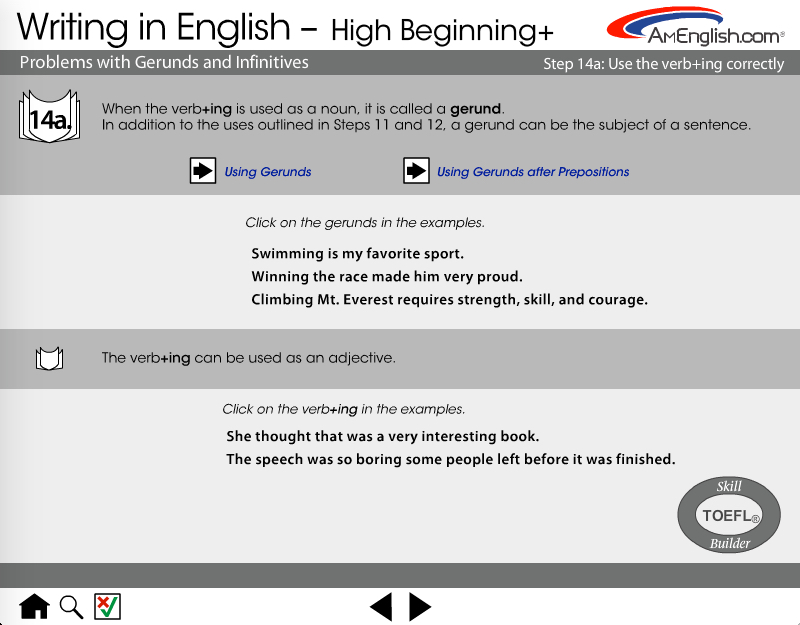
Steps 14a & 14b: Use the verb+ing correctly
(Ideally, this is a review, but it can be a preview.)
Review - Use the verb+ing correctly
Whole class
Write the following sentences on the board (see step 14a):
- Elicit the gerunds: swimming & winning
- Elicit the part of speech: subject
Write the following sentences on the board (see step 14a):
- Elicit the adjectives: interesting & boring
Write the following sentences on the board (see step 14b):
- Elicit the "-ing" & "-ed" forms in the examples.
Write the following sentences on the board (see step 14b):
- Elicit the "-ing" ending on the main verb.
- (considering & applauding)
Group practice I - Teams
Divide the class into two teams. Project practices 4.19 - 4.22 on the board one at a time. Each team has 30 seconds to fill in the blank. Keep score.
Group practice II - Teams
Divide the class into two teams. Project Reviews 1 & 2 on the board. Each team has one minute to fix the mistakes. Keep score.
On your own in the lab/Homework
Take the Post-assessment
Lesson Twelve

Take the Post-assessment in the lab to see if you can improve your score from the homework.
Reflect
Take a moment to reflect on the program overall and share with a partner/the group what has been most useful to you in Writing in English- High Beginning+.
Appendix
- Identify the verb
- Identify modal auxiliaries
- Identify active and passive voice
- Identify the subject, verb and object/complement
- Identify the verb and complement in commands
- Make the subject and verb agree
- Use the correct verb tense
- Use modal auxiliaries correctly
- Use "do" correctly to form negative sentences and questions
- Use active and passive voice appropriately
- Use gerunds or infinitives after verbs that require them
- Use gerunds after prepositions
- Use infinitives in other ways
- Use the verb+ing correctly